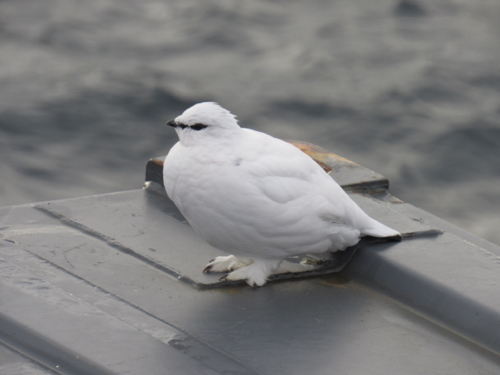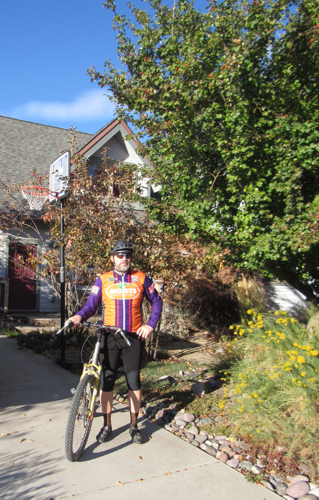My first recollection of the term reentry was that of the Apollo space missions when the capsule that returned with the astronauts inside would reenter the earths atmosphere in a ball of flames. Then later there were similar reentry events with the Space Shuttle program. There was always talk of the reentry angle having to be just right so that the reentry vehicle did not disintegrate. There was also talk of the "blackout period" – the time during reentry when the communications were cut off. Finally there was always those images of the safely returned astronauts being whisked off in wheel chairs to a quarantine trailer where they would be watched carefully for any signs of outer space diseases among other things.
 The CCGS Louis S.St Laurent outside Kugluktuk, NU, Canada.
The CCGS Louis S.St Laurent outside Kugluktuk, NU, Canada.
 A Rock Ptarmigan on the Louis S. St. Laurent.
A Rock Ptarmigan on the Louis S. St. Laurent.
 Close up of a Rock Ptarmigan on the Louis S. St. Laurent.
Close up of a Rock Ptarmigan on the Louis S. St. Laurent.
My reentry to life post 28 days on the Louis S. St. Laurent had some similarities to the space missions reentry. There were several reentry angles that needed to be just right so that the helicopter or airplane I was riding in did not end up as a heap of twisted metal on a runway. There was the blackout period because my cell phone service was nonexistent as we made our way off the ship to Kugluktuk, then Yellowknife, then Edmonton, and finally Seattle where the service kicked back in. Guess I could have tried some email, but the computer was kind of buried in the big bags being schlepped around. There was also a couple days of just hanging out at home, unpacking, going for a long awaited bike ride, cooking a meal for the fam, and avoiding the halls of Big Sky High School just a little longer – quarantine of sorts.
 Luggage being long line slung off of the Louis S. St. Laurent.
Luggage being long line slung off of the Louis S. St. Laurent.
 Headed out on a much awaited bike ride in Missoula, MT.
Headed out on a much awaited bike ride in Missoula, MT.
As our time on the Louis drew to a close I wrote a little bit about the experience and what I was thinking at the time:
Reflections of a Dispatch Writer
Going in to my PolarTREC expedition to the Beaufort Sea on the CCGS Louis S. St. Laurent (aka the Louis or LSSL) I had a vague sense of what was to come. The term that resonated with me based on what I picked up at the PolarTREC training in Fairbanks, was "photo journalist" neither of which I had really considered to be part of my skill-set. I had a camera and I took pictures with it every so often, but more often than not left it at home when I headed out on some adventure. I could write but never really "blogged" about stuff. In fact I found the whole idea of a blog to be kind of irritating. I like to do. Watching others do is not my thing. Reading on the internet about other people doing... not my thing. Snapchat, Instagram, Facebook, Myspace... I don't get it. But others do and so-be-it. Maybe this is an area that I could, should and would have to explore if I was going to pull off this writing thing for an entire month.
I got lucky. When I arrived on the Louis I was introduced to Andrey Proshutinsky, a Senior Scientist at Woods Hole Oceanographic Institute, and he was very interested in working together on putting out our daily reports. One thing I have always gravitated towards is collaborative efforts. It became clear as Andrey and I worked together on the first couple of that we were on the same page and were interested in weaving in lots of science of the Arctic into what we wrote about instead of just blabbing on and on about what we did and saw. Andrey too was a wealth of experience and information about polar science having been a team member of the early efforts of the Soviet Union. He showed me some great photos of he and his comrades landing at the North Pole in 1976 in three airplanes. One carrying people, one carrying equipment and provisions, and one carrying fuel for the planes.
So I set about trying to get a handle on this JOIS 2017 cruise. I scanned through the official "Science Plan for the Oceanographic Research aboard the CCGS Louis S. St-Laurent September 7 to October 2, 2017" document and quickly realized that I needed to talk to all the researchers, technicians, and graduate students about the work they were doing. I also made the conscious decision to talk to non-science crew members about their work on the LSSL and listen to them talk, in their strong Newfoundland accent, about their lives off of the LSSL. Then it was all about writing stories and incorporating relative information into the pieces I produced.
I also discovered that the modern digital camera has a "burst" mode which allows the operator to take lots of shots in a very short amount of time. I began my photography career with a small film camera, so you were very careful about taking shots because you were going to run out of film and it was expensive to develop. Burst mode was something the pros used. But with digital the sky was the limit. I could take 500 shots in a day and in less than 30 minutes I could download them and comb through them and find the real gems. So I got better shots not because I was more skilled but because I had increased my odds of getting good shots by taking lots of shots.
What really struck me, as I got to know the ins and outs of the science being done, was just how interdisciplinary it all was. All the measurements being done were important to every group's research. The ice measurement research was important to the carbon dioxide research, the CDOM work was used by the physical oceanographers in determining the structure of the Beaufort Gyre, the CTD casts were used by virtually everybody including the nutrient analyst who wanted some data to help validate their measurements. All very intertwined and interdependent.
I was also struck by how intertwined the ships crew and the science crew was. The ships crew maneuvered the giant beast and operated the heavy equipment so that the science could get done. The four weeks of science was important to the ship's crew because it gave their work a purpose larger than just operating a vessel in the high Arctic. And the science crew was utterly dependent on the safe operation of the ship to get it to places rarely visited by humans so that a greater understanding of the Beaufort Sea, its Gyre, and its role in the high Arctic could be better understood. In the face of a rapidly changing climate, the Arctic is in many ways a canary in the coal mine.


Comments
Add new comment